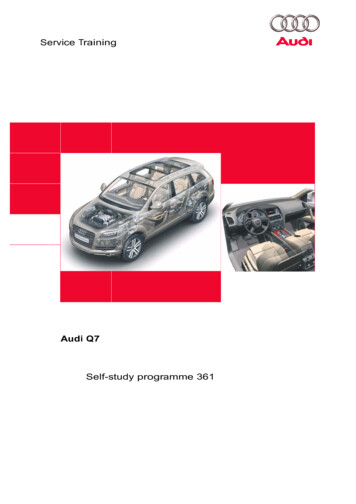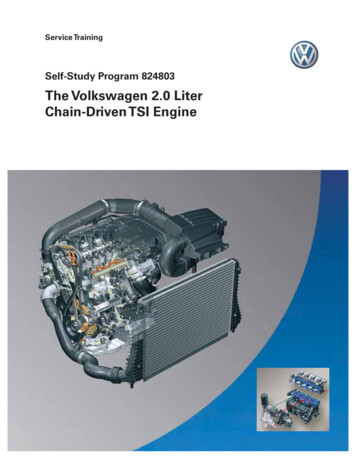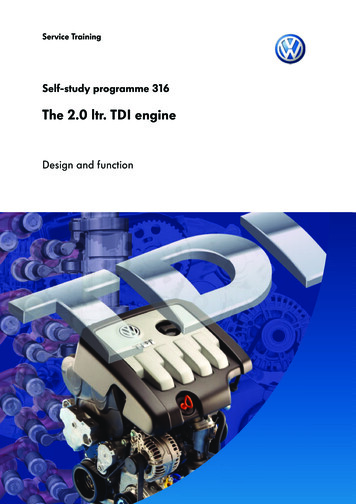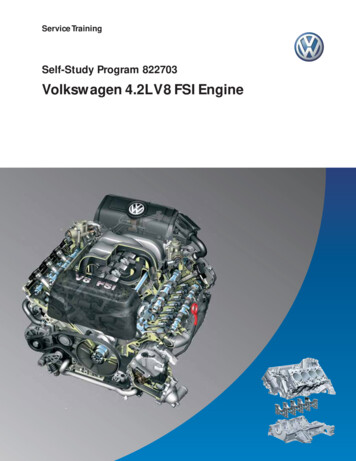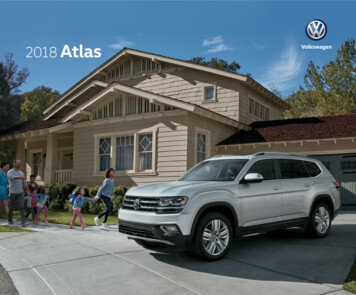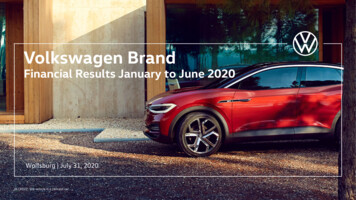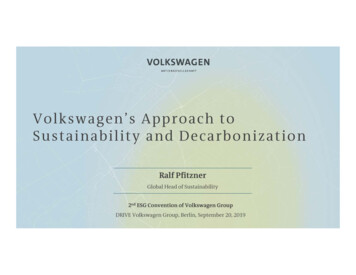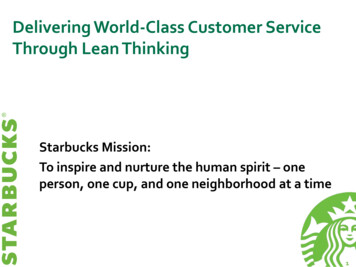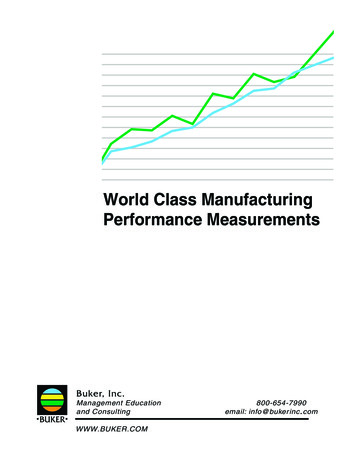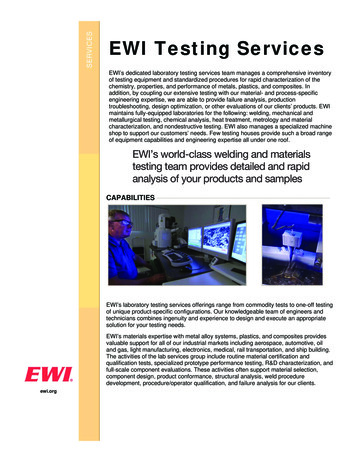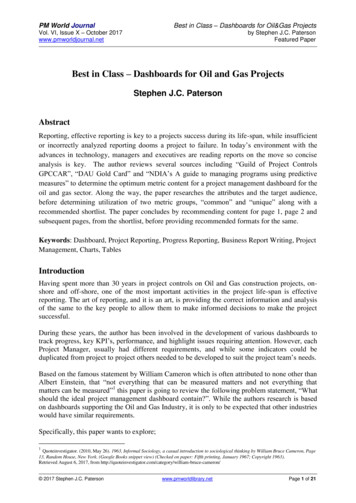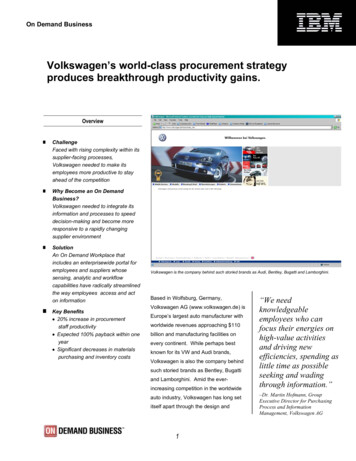
Transcription
On Demand BusinessVolkswagen’s world-class procurement strategyproduces breakthrough productivity gains.Overview ChallengeFaced with rising complexity within itssupplier-facing processes,Volkswagen needed to make itsemployees more productive to stayahead of the competition Why Become an On DemandBusiness?Volkswagen needed to integrate itsinformation and processes to speeddecision-making and become moreresponsive to a rapidly changingsupplier environment SolutionAn On Demand Workplace thatincludes an enterprisewide portal foremployees and suppliers whosesensing, analytic and workflowcapabilities have radically streamlinedthe way employees access and acton information Key Benefits 20% increase in procurementstaff productivity Expected 100% payback within oneyear Significant decreases in materialspurchasing and inventory costsVolkswagen is the company behind such storied brands as Audi, Bentley, Bugatti and Lamborghini.Based in Wolfsburg, Germany,Volkswagen AG (www.volkswagen.de) isEurope’s largest auto manufacturer withworldwide revenues approaching 110billion and manufacturing facilities onevery continent. While perhaps bestknown for its VW and Audi brands,Volkswagen is also the company behindsuch storied brands as Bentley, Bugattiand Lamborghini. Amid the everincreasing competition in the worldwideauto industry, Volkswagen has long setitself apart through the design and1“We needknowledgeableemployees who canfocus their energies onhigh-value activitiesand driving newefficiencies, spending aslittle time as possibleseeking and wadingthrough information.”–Dr. Martin Hofmann, GroupExecutive Director for PurchasingProcess and InformationManagement, Volkswagen AG
Integrating solutions that help on demand businessOn Demand Business Benefits Expected payback within one year 20% increase in productivity forVolkswagen’s procurement staff Shorter order-to-delivery cycles byvirtue of more efficient processes Improved ability for Volkswagenprocurement staff to focus on highvalue-added activities More rapid response to impendingshortages and surpluses, therebyreducing bottlenecks and inventorycosts Improved ability to leverageengineering of its cars—yielding the mix of speed and simplicity thatepitomizes “Euro” styling.Speed and simplicity have also grown in importance for the company’sunderlying business processes. Driven by relentless industrycompetition, the need for maximum employee productivity, shorter cyclesand lower costs has never been greater. At the same time, achievingthese efficiencies has become an increasing challenge. One big reasonis a shift in consumers’ buying practices, with more and more buyerscustomizing their cars at the dealership—from upholstery and color toengines.As a result of this trend, car manufacturers’ business processes—alreadycomplex—have become even more so. Once an order is placed at apurchasing economies through a moredealership, it flows through a variety of systems, to the productionunified view of Volkswagen’s supplyordering system, to the production assembly system and finally to thechainlogistics system, which closes the loop when it delivers the car to thecustomer. While more options means more choices for Volkswagen’scustomers, it also means an exponential increase in the variations ofparts moving through the assembly process, each of which needs to beordered, shipped and tracked. In many ways, this order-to-delivery cyclerepresents the frontline of the competitive battle being waged in the autoindustry. As part of this battle, Volkswagen and its competitors need tomaximize the efficiency of every stage of this cycle in order to reducetheir costs and to speed delivery of new vehicles to customers.The order-to-deliverycycle represents thefrontline of thecompetitive battle beingwaged in the autoindustry. Volkswagenand its competitors needto maximize theefficiency of every stageof this cycle in order toreduce their costs and tospeed delivery of newvehicles to customers.However, with Volkswagen’s processes becoming more and morecomplex, optimizing the efficiency has in turn become even more of achallenge. The industry’s incessant pressure to control cost compelledthe company to face this challenge.Complexity: the looming challengeTo get on a higher plane of efficiency going forward, the companyneeded to fundamentally change its core processes. Within Volkswagen,the efficiency of processes is defined by how well these processesoperate under “normal,” predictable conditions and, perhaps moreimportantly, their ability to dynamically adapt to key changes in itsenvironment and still deliver the best possible outcome. Given the sheerscale of Volkswagen’s procurement activities—global purchasing volumeapproaches 80 billion annually—the company is constantly buffeted byexternal events. Forecasts change. Commodity prices rise and fall.2
Suppliers go out of business. And for every one of these events, Volkswagen’sability to respond rapidly and correctly is a key measure of its process efficiencyand, ultimately, its long-term competitiveness. In addressing the challenge,The On Demand Workplace Defined A set of services and software thatVolkswagen focused on a basic, yet critical, truth—that the root of businesssimplifies employee access to content,processes is the use of information to trigger action. The key to more effectiveapplications, people and processes.procurement practices, says Dr. Martin Hofmann, VW’s Group Executive Director A secure, enterprisewide portal thatfor Purchasing Process and Information Management, was to redefine the wayenables employees to dynamicallyemployees and suppliers access knowledge, thereby unleashing their potential tointeract with integrated businessadd value. “Knowledge management has become one of the most critical successprocesses, other employees, partners,factors in the auto industry,” says Hofmann. “We need knowledgeable employeessuppliers and customers.who can focus their energies on high-value activities and driving new efficiencies,spending as little time as possible seeking and wading through information.” A personalized workplace thatbecomes a single destination foremployees to do work.A number of factors stood in the way of this vision. First and foremost was a lack ofcommon processes and information architectures. While a truly global company,Volkswagen’s processes and systems are highly localized and departmentalized;each location runs a different set of processes, applications and user interfaces,operating in different languages and time zones. Having to navigate through thesedisparate systems bogged down decision-making in the company’s procurementoperations, and made it more cumbersome for suppliers, who were required to logonto as many as 20 systems to get the information they needed. Underscoring theneed to act, Dr. Hofmann cited an internal study finding that purchasing agents spent70 percent of their time in the act of searching for, retrieving, analyzing, validating andmoving information, with only 30 percent spent on value-added activities like findingnew potential cost savings and negotiating better prices with suppliers. “It was clearthat this ratio had to be reversed,” notes Dr. Hofmann. The only way to do that was toradically change the way people worked with information across organizationalboundaries to make them more responsive to events that affect them.”Speed through sense and respond capabilityWorking with IBM, Volkswagen began putting in place a new system designed tosimplify and automate the process by which employees and suppliers capture,access, analyze and use information. According to Dr. Hofmann, the aim of the newsystem is to reverse the current application paradigm, under which the burden ofseeking information falls entirely on end users. “Our vision was to leveragetechnology to create a sense and respond capability that would support moreeffective decision-making,” says Hofmann. “This means the right intelligence andworkflow automatically goes to the right user in response to an outside event—thevery definition of an end-to-end adaptive process.” Volkswagen’s new On DemandWorkplace solution is comprised of four main components:3Volkswagen’s new Jetta Wagon
Sensing capability, to automatically identify and capture externalKey Componentsevents such as price changes, competitive issues or supplier-relatedSoftwaredevelopments IBM WebSphere Application Server IBM WebSphere Portal IBM WebSphere BusinessIntegration Personalized information delivery, using a portal to send the rightinformation to the right business user Integrated analytics, using business intelligence to analyze andcontextualize the event-driven information IBM WebSphere MQ IBM WebSphere Edge Servertechnology to trigger automatic actions across a range of relevant IBM DB2 Universal Database business process areas IBM Tivoli Access ManagerBusiness process automation, which employs advanced workflowThe dramatic impact on procurement productivity is most evident whenServers IBM eServer xSeries compared with the way the process had formerly been conducted. In atypical day, procurement staff are bombarded with unstructuredinformation. Telephone calls come in about supply shortages, or aServicesprocurement officer might read about a supplier going under in the trade IBM Business Consulting Servicespress. For these and other events, procurement staff need to assess IBM Software Groupwhat the event means for Volkswagen’s production needs, what business IBM Böeblingen DevelopmentLaboratoryprocesses will be affected and what actions will be required to workthrough the situation. The new system alerts Volkswagen of an eventthat could cause a parts shortage, and triggers an automatic checking ofparts inventories, alternative sources and the impact on vehicleproduction, as well as the overall financial impact on the balance sheet.Tasks that used to take days or hours now take minutes. Freed ofinformation overload, procurement staff can now focus their time andeffort on producing the optimal outcome—minimizing the downside andmaking the most of cost-saving opportunities.Volkswagen and IBM team up for smarter procurementTo build the solution, Volkswagen selected IBM WebSphere technologyto not only connect employees and suppliers to information andapplications throughout the company but also enable the kind ofautomated, data-enriched workflow environment it envisioned. Since thenew solution would have to integrate with a wide range of systems—bothoff-the-shelf and home-grown—strong support for open standards was amust, as was the ability to personalize information and push it out to theright user at the right time. To meet this need, Volkswagen selected IBMWebSphere Portal to provide employees and suppliers with a single pointof access to critical supply chain data and applications. To transparentlyintegrate the procurement system with various backend systems—a4
critical element of the solution—Volkswagen employed IBM WebSphere MQ. Toperform the business process integration underlying the solution’s automatedworkflows, the company chose IBM WebSphere Business Integration. Running on acluster of IBM eServer xSeries servers, the portal solution also employs IBM DB2Universal Database to house key information and IBM Tivoli Access Manager forauthentication. Load balancing within the cluster is performed by IBM WebSphereEdge Server.With Volkswagen’s solution uniting a huge, heterogeneous infrastructure, ease of“We hope to leverageIBM's vast knowledge ofindustry best practices,as well as theirknowledge of on demandtechnology to identifyand implement our keyprocesses faster.”integration and standards support were immeasurably important. But with therequirement that the solution ramp from a handful of pilot users to more than 35,000in a matter of months, Dr. Hofmann notes that scalability and resiliency were alsotop-tier concerns. “We felt that the overall flexibility and scalability of theWebSphere architecture would allow us to grow smoothly,” says Hofmann.IBM’s role in the project was to provide the technology and the expertise needed tomake Volkswagen’s sense-and-respond vision a reality. IBM Business ConsultingServices worked with the company’s internal consulting organization on businessprocess design and integration, while staff from the IBM Software Group definedfunctional requirements, designed the solution and played a key role in legacyintegration. The IBM Böeblingen Development Laboratory assisted in defining thesolution’s future needs as well as troubleshooting. While the solution went intoproduction a year after the start of the project, Volkswagen’s strategy called for anincremental rollout, with new features and elements added continuously.The Impact: smarter employees, shorter and faster cyclesBy integrating sensing capabilities with a deep knowledge base and a highlyautomated workflow, Volkswagen’s procurement staff is becoming highly efficient. Ayear into deployment, the company has targeted a 20 percent rise in staffproductivity—and that’s just the beginning. Employees and suppliers now spendless time finding information and more time acting on it. Freed from inefficientprocesses, these employees can now focus on further process improvements—thekind that will reward Volkswagen in the punishing competitive climate of today’sglobal auto industry. More efficient employees and integrated processes have alsomade the company more responsive to supply-related developments, and in sodoing have shortened the order-to-delivery cycle, enabling customers to get theircars faster. In addition to cutting time, a tighter, more informed supply chain hasalso enabled Volkswagen to cut costs in a variety of ways. By keeping ahead of thecurve on impending shortages and surpluses, the solution helps keep inventorycarrying costs down and keeps bottlenecks to a minimum. Dr. Hofmann also seesthe higher visibility across the supply chain, made possible by the solution, as a5–Dr. Martin Hofmann
major driver of future costsenvironment. Having a faster,savings. “We’re now better ablemore productive set ofto identify synergies that willprocesses will also help us keepdrive costs down,” says Dr.our costs down and stayHofmann. “The more we cancompetitive.”coordinate our purchasinginternally, the better we’ll beDr. Hofmann also sees IBMable to capitalize on volume-playing a key role in Copyright IBM Corporation 2004based effects and reducedVolkswagen’s increasingly onIBM Corporationcomplexity.” For the portion ofdemand future by continuing toCorporate Marketingthe project completed thus far,help the company redefine andNew Orchard Roadhe expects to achieve 100connect business processes.percent payback “well within a“We hope to leverage IBM’syear.”vast knowledge of industry bestProduced in the United States of America 06-04practices, as well as theirAll Rights ReservedArmonk, NY 10504U.S.A.Driving toward an on demand futureknowledge of on demandAfter targeting the initial phasetechnology to identify andof the deployment in theimplement our key processesIBM logo, Tivoli, WebSphere and xSeries areprocurement area, Volkswagenfaster,” explains Dr. Hofmann.trademarks of International Business Machinesplans to expand its sense-and-“This will make us much fasterCorporation in the United States, other countries or both.respond On Demand Workplacein terms of order-to-deliveryOther company, product or service names may beframework to the company as acycles, product developmenttrademarks or service marks of others.whole. By relying on theand our ability to connect to theWebSphere platform to link alloutside world.”For more informationproductivity improvements forthe company’s 300,000worldwide employees.“Eventually, Volkswagen will befully connected both inside andThis case study illustrates how one IBM customer usesresults.References in this publication to IBM products orthe enterprise—Dr. Hofmannexpects similar levels ofdemand lockup, the e-business logo, eServer, IBM, theIBM products. There is no guarantee of comparableof Volkswagen’s businessprocesses—inside and beyondDB2, DB2 Universal Database, the e-business onPlease contact your IBM salesservices do not imply that IBM intends to make themrepresentative.available in all countries in which IBM operates.Visit us at:ibm.com/ondemandoutside of the company, basedon well-defined business eventsand business scenarios,” saysDr. Hofmann. “We will be ableto respond rapidly—in somecases simultaneously—tocritical events in our business6
4 Sensing capability, to automatically identify and capture external events such as price changes, competitive issues or supplier-related developments Personalized information delivery, using a portal to send the right information to the right business user Integrated analytics, using business intelligence
